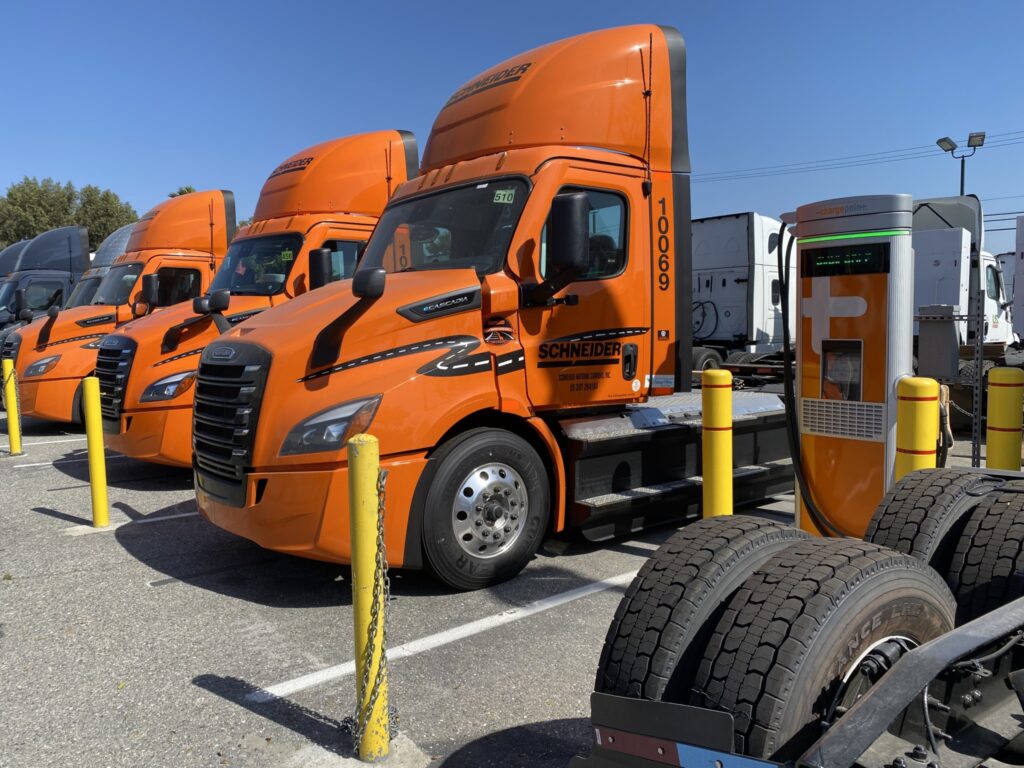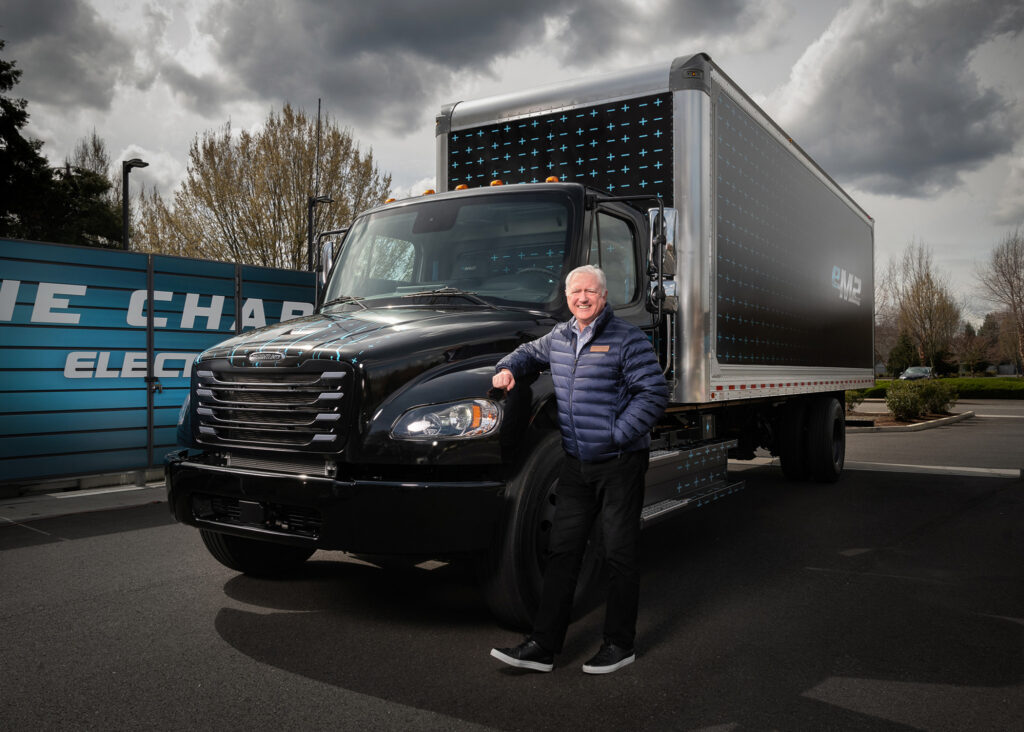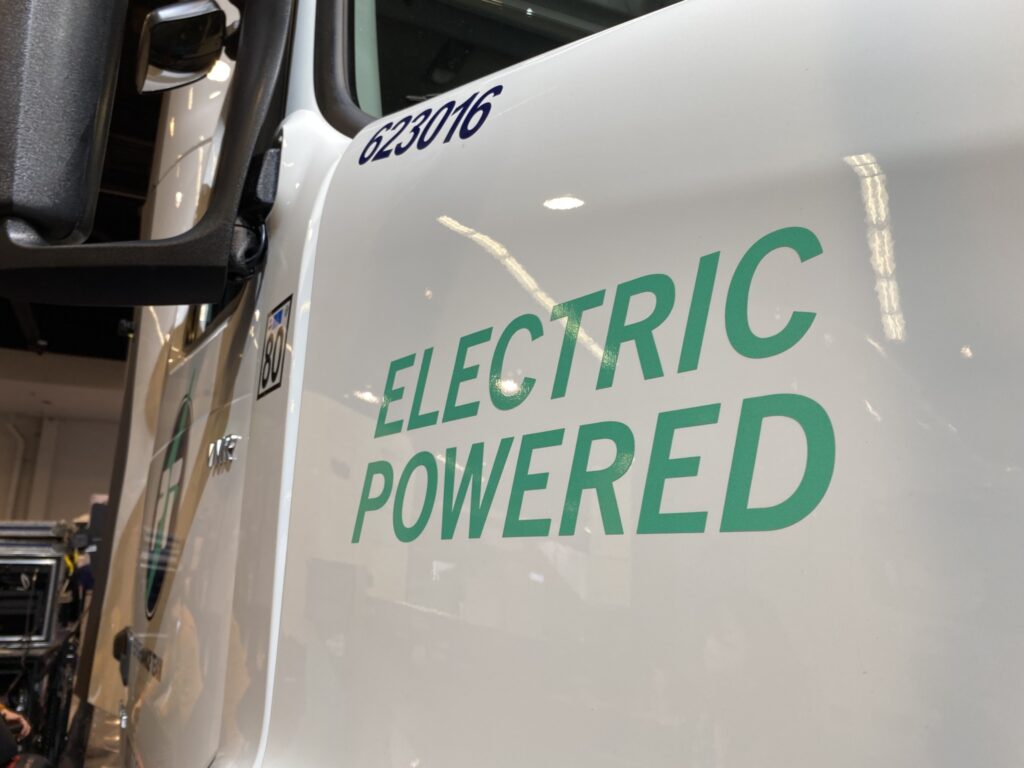Charging infrastructure delays temper rollouts of battery-electric trucks
The handful of orange trucks parked outside Velocity Truck Center are merely a sign of bigger things to come. Schneider has ordered 92 of these Freightliner eCascadias as it prepares for the fleet’s first broad rollout of battery-electric vehicles. And a three-week run hosted by the North American Council for Freight Efficiency (NACFE) will measure just how productive they can be.
“We wanted to go big, and we wanted to really stress test this,” the fleet’s vice-president – equipment engineering Jake Vandeloo said. Trucks are just part of the equation, too. Schneider’s facility in South El Monte, California, is also upgrading its power supply to support 16 related chargers.

Battery-electric Class 8 trucks like these are now emerging across North America, largely on drayage and local routes that can be completed on a single charge. By some estimates there are about 500 such vehicles in service, and various OEMs have announced wider production plans in the wake of successful customer tests.
But executives speaking during several sessions at this year’s ACT Expo – an annual showcase of zero-emission vehicles – were tempering expectations about the timing of widescale rollouts because of the delays in establishing charging infrastructure.
The steps to charge more than a handful of trucks at any single location are decidedly more complex than repurposing a shop circuit that once supported a welding unit.

Charger infrastructure delays and costs
“You may have the ultimate desire to install a big charging station next year, but the odds are it’s probably going to be two or three years unless you just get lucky in terms of where some existing power happens to be,” Daimler Truck North America president and CEO John O’Leary said during a media briefing.
Fleets simply can’t find the charging infrastructure they need, he continued during a keynote presentation later in the day. “Infrastructure buildouts are flailing, and we’re destined to fail to meet the ambitious goals of the state, of our country, and the world, until emphasis is put on meeting the charging needs of the electric fleet.
“The nation’s fleet can’t achieve the desired reduction in emissions, nor can they realize the usefulness of these [electric trucks], if they can’t charge where those vehicles are domiciled.”
“Infrastructure buildouts are flailing.”
– John O’Leary, Daimler Truck North America
Daimler Truck estimates that climate targets over the coming decade will require US$52 billion in investments to generate, transmit and distribute the energy to support medium-duty and heavy-duty vehicles. And that’s not counting the real estate investments to site the chargers. California’s rules alone will require 30 new DC chargers per day in the years leading to 2026, while the Advanced Clean Trucks rule will require the state to add 5 million kilowatts of installed capacity by 2035.
“If we ignore this reality, if we ignore the energy demand, if we ignore the differences in charging needs, we’re going to find a lot of orphaned equipment sitting at depots or sitting idle,” O’Leary said.
Rules for infrastructure providers
“There’s a significant percentage of HVIP [California’s Hybrid and Zero-Emission Truck and Bus Voucher Incentive Project] vouchers not being picked up at the moment because the charging infrastructure is not there,” Volvo Trucks North America president Peter Voorhoeve added in an interview.
While OEMs face sales mandates under California’s Advanced Clean Truck rules, and fleets need to adopt ever-increasing numbers of zero-emission vehicles under Advanced Clean Fleets (ACF) rules, he wonders whether those who supply the power should face tougher guidelines as well.
“We need to have something like that for the utility operators or the grid operator,” Voorhoeve said, noting it can take 12 to 24 months to secure permits for electrical infrastructure upgrades. “The truck is there. The charger is there. The utility company is not there switching it on.”
“There’s no rule to force the utilities [to act quickly], and that’s the big bottleneck for everybody.”
– Salim Youssefzadeh, WattEV
WattEV is taking a different approach than established fleets, establishing charging depots as a central step in a truck-as-a-service model. Its first site in Long Beach, California, is to be joined by four similar facilities – each with 5 megawatts of power and the ability to recharge more than 150 trucks.
“It’s about finding sites that are close to the customers – strategically located, have access to power, and then looking at the future and how we can scale it up from there,” said CEO and founder Salim Youssefzadeh.
But he echoes concerns about the delays in establishing electrical infrastructure.
“There’s no rule to force the utilities [to act quickly], and that’s the big bottleneck for everybody,” Youssefzadeh said. “Having the ability to create depots where not only our own fleet can use them, but other fleets can come in and use them, is crucial to electrifying the entire network as a whole.”

Evolving chargers, limited harmonization
Such delays can affect plans in more ways than one. After waiting three years for a connection, fleets may not be able to use the latest generation of charger because it wasn’t referenced when a program was announced, said Ashley Horvat, Schneider Electric’s VP – head of eMobility, North America.
“Sometimes you can’t use the charger that you want to use because it’s not in that program,” she observed, noting how the products can evolve. “That’s a struggle because this is a long-term investment.”
“The utility industry loves standards – except they have a billion of them,” added Pasquale Romano, president and CEO of ChargePoint, a network of EV charging stations. “We need some form of harmonization because it slows the whole industry down. You can’t get common rate structures. You can’t get commonality of API [an Application Programming Interface] for signaling, all that sort of stuff. And it just slows us all down because you have to basically hit too many targets.
“A lot of the problems that we’re having are not the fundamental technology. They’re all the blocking and tackling, boring stuff,” Romano said.
There is also growing competition for trained labor in the electrical trades, he added. “It’s not really the choke point right now that’s significant, but it will be.”
Navistar believes it has found part of the solution in a deal with Quanta Services, a company billed as North America’s largest supplier of specialty electric power grid infrastructure, which will supply engineering, construction, and maintenance.
“They can help us with the site assessment. They can help us understand how much power is coming in there and what needs to be done to get more power, because you’ve got the lines to the substation, to the transformer, and all those pieces,” said Trish Reed, Navistar’s vice-president – zero emissions.
Investments in renewable energy
But needs extend well beyond the cables that connect to a fleet facility. Investments will be required in the underlying energy sources as well, said Amy Davis, president of Accelera – the Cummins business unit that focuses on low-carbon options like batteries and hydrogen.
“Investments in renewable energy sources need to surpass that of fossil fuels by a factor of four over the next decade,” she said in her keynote address. “Today, for every dollar put toward fossil fuels, about 90 cents goes to low-carbon energy solutions. That ratio needs to change dramatically – going up to an average of $4 invested for every dollar in fossil fuels.
“The amount of green energy infrastructure in our country is insufficient. For our industry to decarbonize we need renewable energy sources to make green hydrogen and power our charging stations.”
Michael Berube of the U.S. Department of Energy Office of Energy Efficiency and Renewable Energy admitted the industry will fall short of decarbonization goals without the infrastructure.
“If we don’t have the infrastructure there, that will become the limiter. So we’re very much focused working with utilities. What do we need to do for planning now? How do we identify where those loads are likely to be? How do we get ourselves ready?
“If we don’t have the infrastructure there, that will become the limiter.”
– Michael Berube, U.S. Department of Energy Office of Energy Efficiency and Renewable Energy
“We are building a DC fast-charging network across the entire country,” he said. “That will cover arguably a little more light-duty than the medium-heavy duty, but I think on the fleet side we will start seeing those corridors start to build out. It’ll be a little bit slower, but initially a lot of the behind the meter, the hub-to-hub, the vehicles coming back to base charging, and that can be done everywhere.”
Some rethinking about the way individual fleets operate can help, too.
“You don’t need to think, ‘Will I need every truck on a plug every night for eight hours?’” Mack Trucks North America president Jonathan Randall explained in an interview. He uses refuse trucks like the Mack LR Electric as an example. A quiet-running battery-electric truck may be allowed to operate earlier and later in the day than its diesel-powered counterpart. That can affect the timing of when chargers need to be accessed.
“It’s not just buying chargers,” he said.
Have your say
This is a moderated forum. Comments will no longer be published unless they are accompanied by a first and last name and a verifiable email address. (Today's Trucking will not publish or share the email address.) Profane language and content deemed to be libelous, racist, or threatening in nature will not be published under any circumstances.